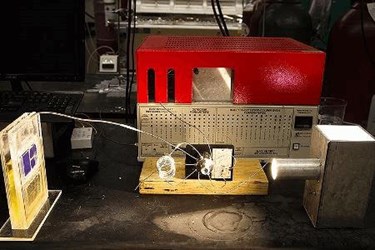'Artificial Leaf' Uses Sunlight to Convert Carbon Dioxide Into Fuel
By Jof Enriquez,
Follow me on Twitter @jofenriq

An "artificial leaf" device featuring solar cell technology that can convert and recycle atmospheric carbon dioxide into hydrocarbons could lessen dependence on fossil fuels and mitigate climate change, according to a team of researchers at the University of Illinois at Chicago (UIC).
Similar to how plants trap sunlight during photosynthesis to convert carbon dioxide into sugar, the artificial leaf harnesses solar energy to capture and break down carbon dioxide (CO2) and transform it into syngas (synthesis gas, a mixture of hydrogen and carbon monoxide) that can later be turned into fuels, such as diesel.
“The new solar cell is not photovoltaic — it’s photosynthetic,” said Amin Salehi-Khojin, assistant professor of mechanical and industrial engineering at UIC and senior author on the study, in a press release. “Instead of producing energy in an unsustainable one-way route from fossil fuels to greenhouse gas, we can now reverse the process and recycle atmospheric carbon into fuel using sunlight.”
Scientists are looking into how natural photosynthetic cells utilize solar energy so that they can possibly leverage that process to make artificial solar cells more efficient at converting energy. Some researchers are trying to locate the routes along which solar energy is transported, while others, such as the UIC team, are looking at how to hasten the energy conversion process. The UIC researchers think their solar cell technology is a breakthrough.
“This is a real artificial leaf,” Salehi-Khojin told the digital news magazine TakePart. “We use the energy from the sun, and by CO2 remediation, we store the energy of the sun in the chemical bonds” of the syngas.
However, "the chemical inertness of CO2 renders many electrochemical and photochemical conversion processes inefficient," wrote the researchers in the July 29 issue of the journal Science. Further, chemical reactions that convert CO2 into hydrocarbons – known as reduction reactions – rely on expensive precious metals such as silver, platinum, or palladium.
Looking for an inexpensive and energy-efficient alternative, Salehi-Khojin and his team used nanoflake tungsten diselenide (a type of nano-structured compound called transition metal dichalcogenides, or TMDCs) as the catalyst in breaking carbon dioxide’s chemical bonds. To enhance efficiency, they paired this with an unconventional ionic liquid as the electrolyte inside a two-compartment, three-electrode electrochemical cell.
As described in further detail: the UIC artificial leaf consists of two silicon triple-junction photovoltaic cells of 18 square centimeters to harvest light; the tungsten diselenide and ionic liquid co-catalyst system on the cathode side; and cobalt oxide in potassium phosphate electrolyte on the anode side. When light of 100 watts per square meter – about the average intensity of sun’s light reaching the Earth’s surface – energizes the cell, hydrogen and carbon monoxide gas bubble up from the cathode, while free oxygen and hydrogen ions are produced at the anode.
“The hydrogen ions diffuse through a membrane to the cathode side, to participate in the carbon dioxide reduction reaction,” said UIC postdoctoral researcher and first study author Mohammad Asadi.
The UIC team is seeking grants and investors to further develop its prototype device toward full commercialization in two to three years. They envision the technology being used in solar farms and in smaller installations at power plants and industrial facilities to capture CO2 emissions.
“We need collaborators from industry to scale up the system, because that will need different expertise in terms of the manufacturing,” Salehi-Khojin told TakePart. “Maybe we need to optimize the geometries and the design — all that sort of stuff.”
Salehi-Khojin thinks that, if successful, the team’s device could produce fuel at about $2 a gallon, and could make drilling for oil or gas obsolete, according to TakePart. The researchers’ platform might be considered carbon-neutral, since the amount of carbon captured by the solar cell from the atmosphere is theoretically equivalent to the amount released.
The UIC team has filed an application for a provisional patent for its solar cell, developed with funding from the Department of Energy and the National Science Foundation.
